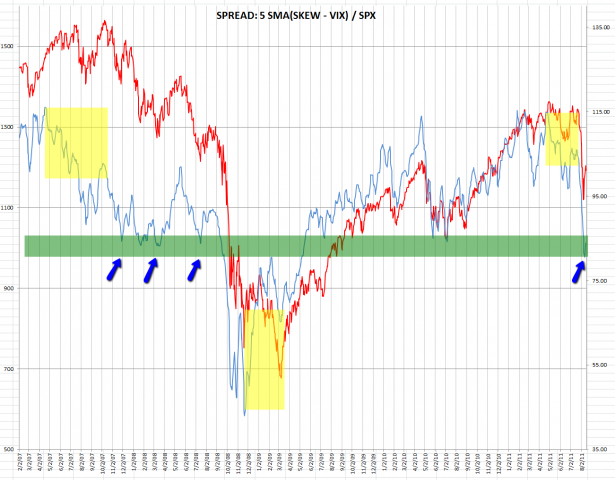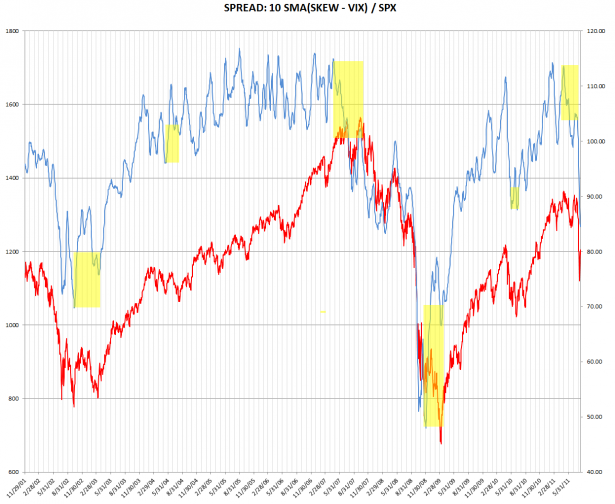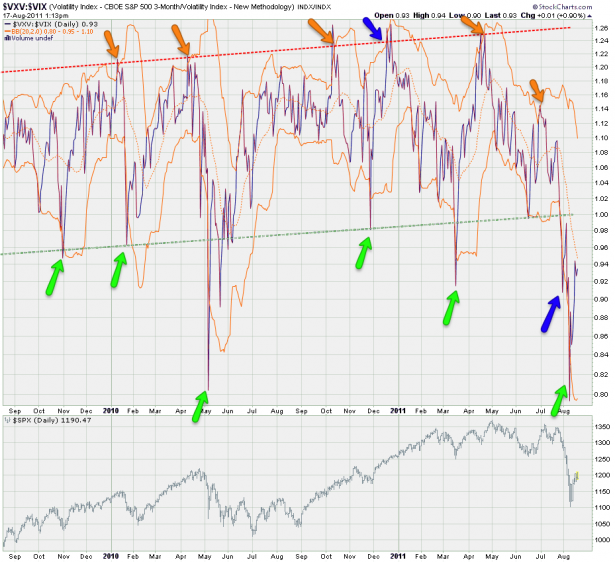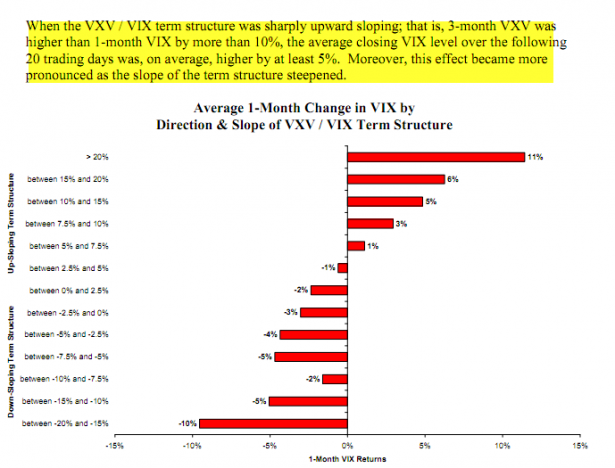Those Bastards Always Know
Those Bastards Always Know
Volar’s most excellent treatise on the VXV/VIX correlation, and in particular on the COBE SKEW inspired me to scrape together my admittedly lousy Excel skills in order to produce some charts on my own. Once I finally got all the data aligned (did I mention I suck in Excel) the scales fell from my eyes – yes, in a biblical way:
What we are looking at is a spread between the CBOE SKEW and good ole’ Mr. VIX. Volar sent me some historical data for the VXV just now and I may put together a SKEW-VXV spread as well. If you don’t know what the CBOE SKEW is all about then I strongly suggest you read up on Volar’s post as he makes a great effort of conveying the basic concept. Plus there are plenty of links on the subject – Google is your friend.
Anyway, this yet once again confirms that the big boys are always in the know and that, at least on the long term front, the writing of major trend changes is usually on the wall way ahead of time. Make sure your tinfoil hat is tightly fastened before you continue reading this.
I have highlighted the pertinent divergences between the spread and the SPX on the chart above. This early warning system is way worth the effort of manually importing the data into Excel and I cannot over emphasize how important this chart is to us from a long term perspective. What’s clearly shown here are major divergences in the spread vs. the SPX ahead of long term trend changes. The chart is also useful in plotting medium term bounces and I will produce more detailed charts moving forward.
Now let’s take a look at a zoomed in version to get a better view at where we’re heading next:
[amprotect=nonmember]
Charts and commentary below for anyone donning a secret decoder ring. If you are interested in becoming a Gold member then don’t waste time and sign up here. And if you are a Zero subscriber it includes access to all Gold posts, so you actually get double the bang for your buck.
[/amprotect]
[amprotect=1,13,9,12,5]

Seems the 80 mark usually is good for a few bounces after a bearish trend change – at least that’s what happened back in 2008. What we want to see here are a few bounces along with a mildly up-trending spread, which preferably should not recover above the 100 mark.
If we continue downward the 80% mark should also be good for roughly timing intermediate lows, although we do have plenty of other sentiment measures for that.
I also put together a brand spanking new VXV:VIX chart, which is a bit different to how Volar is plotting it. Maybe less fancy but as so often those Bollingers turn out to be a great way to anticipate reversal levels. I have drawn pointers at all pertinent spikes – the unsuccessful ones are in blue.
The 1.0 mark is usually a good place for a long position – unless of course it fails at which point we see spikes a lot lower. This also supports an observation I made yesterday when reading the CBOE white paper:
In other words – once we see a delta of 10% plus between the VIX and the VXV the odds of reaching a higher reading (i.e. more extreme delta, most likely caused by a VIX drop or spike) over the next 20 trading days is very high. The paper suggests that the VIX/VXV correlation is about 92%.
To dumb it down for everyone: Once we see extreme delta on that VXV-VIX chart (the paper uses a ratio I think – I prefer the spread) then the odds for a continuation within the next 20 days are pretty high. As we just experienced a 20%+ drop within one month this suggests that statistically speaking we should expect more short term volatility looming ahead.
I’d love for Volar to chime in on all this as well. It’s important that we all collaborate in order to clearly define our rules and basic assumptions and leave nothing up to interpretation.
Cheers,
Mole
*** OK Volar is chiming in here, bc I dont want to give away all of our secrets to the mass public.
I would only add that the VIX/VXV ratio does have some expectancy of the VIX, but the key is that it is 92% correlated to the VIX, while the SKEW is not at all.
Here is the correlation chart of SKEW to VIX.
Which makes the Skew even more neat as an indicator, as it is independent.
Well the SKEW is calculated on the front month options, and what i am finding is that the skew really does not change on back-dated options.
See here is the DEC Emini IV/Moneyness/Time ratio (Smile).
So what does that mean? Well it actually means that the MMs are making a short-term bet, which is what we need as market timers.
Finally the only think I would add is that my Black Swan Index is used to tell when both the SKEW and VIX/VXV ratios are extreme- just for clarification. Mole is running the SKEW- VIX, which is brilliant, because they are uncorrelated. This is more of a longer-term indicator.
Cheers,
Volar
[/amprotect]




















